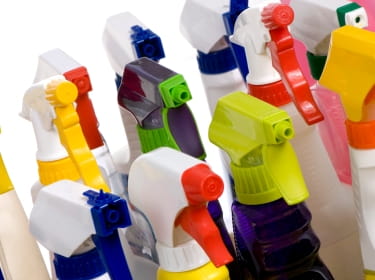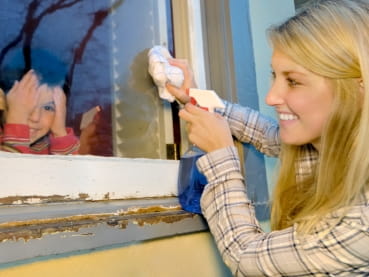Children and Spray Bottles: A Hazard

The Bottom Line
More and more household cleaning products are found in spray bottles. More and more children are being poisoned by those products. Cleaning products in spray bottles are now the leading source of cleaning products that poison children. Most injuries are to the eyes and head. It's important to wash the skin and eyes right away with lots of running water.

The Full Story
More and more household cleaning products are found in spray bottles. And more and more children are being poisoned by those products. In fact, products stored in spray bottles accounted for more poisoned children than any other source of cleaning products.
Most of those children had the chemicals in their eyes or somewhere else on their heads. Eye injuries were much more common when the chemical was in a spray bottle than any other container. Most of the time, the product was actually being used by someone else.
Among the findings of a study of more than 267,000 young children who were treated in emergency rooms for injuries related to household cleaning products. This is a bit surprising, as the rate of household product injuries from other sources actually declined during the study period. Only spray-bottle related injuries increased.
Spray bottles should be stored out of sight and reach of children when they're not in use. Some additional poison prevention measures are needed for spray bottles:
- Parents must be careful when using these products around children. It would be best if children and pets were in another room when a parent is using a cleaning product in a spray bottle.
- The spray nozzle should be in the "off" position when the product isn't being used, so that children can't operate the nozzle themselves.
If a child (or anyone) gets a cleaning product in the eyes, the most important thing is to rinse the eyes right away. Remove contact lenses. Running water is best; any comfortable temperature is OK. If a child can get into the shower, have them blink while water is running over the eyes. For young children, wrap their arms at their sides, and then pour water over the eyes while holding the child over the sink. Continue for 15 minutes. Then, call Poison Control at 1-800-222-1222.
If the product is on the skin, rinsing with running water for 15 minutes is important. Take off any clothing with the product on it. After a 15-minute rinse, use the webPOISONCONTROL® online tool for guidance or call Poison Control at 1-800-222-1222.
If the product is swallowed, use the webPOISONCONTROL® online tool for guidance or call Poison Control at 1-800-222-1222.
Rose Ann Gould Soloway, RN, BSN, MSEd, DABAT emerita
Clinical Toxicologist
Poisoned?
Call 1-800-222-1222 or
Prevention Tips
- Spray bottles should be stored out of sight and reach of children when they're not in use.
- Parents must be careful when using these products around children. It would be best if children and pets were in another room when a parent is using a cleaning product in a spray bottle.
- The spray nozzle should be in the "off" position when the product isn't being used, so that children can't operate the nozzle themselves.
This Really Happened
Case 1: A 3-year-old child was found spraying oven cleaner in the air. That meant she was breathing in the product. Mom decided to watch her at home. The child coughed all that night; the next morning, she had a fever. She was taken to the emergency room and diagnosed with pneumonia. The child was given antibiotics for the pneumonia and acetaminophen and ibuprofen for the fever. After four days, her symptoms were gone.
Case 2: A 2-year-old girl and her 1-year-old brother were found playing with oven cleaner. It contained sodium hydroxide, a very caustic chemical. They had sprayed each other in the face, eyes, mouth, and all over the body. Both children developed red, painful burns on their faces and chests. Their eyes were red and irritated. The little boy developed wheezing and difficulty breathing. The little girl developed swelling inside her mouth that could make it hard to breathe.
The children were taken to the emergency room by ambulance. Their eyes were irrigated with 8 liters of saline. Both children were evaluated by specialists in burns of the eye, skin, and throat.
Both children had burns on their faces and eyes. The little boy's wheezing resolved without treatment. The swelling stopped getting worse; both children were able to swallow normally.
The children were discharged with antibiotic ointments for the skin and the eyes. After four days, the burns healed and the swelling went down.
For More Information
Caustic Chemicals (The Poison Post®)
References
McKenzie LB, Ahir N, Stolz U, Nelson NG. Household cleaning product-related injuries treated in US emergency departments in 1990-2006. Pediatrics. 2010;126:509-516.Poisoned?
Call 1-800-222-1222 or
Prevention Tips
- Spray bottles should be stored out of sight and reach of children when they're not in use.
- Parents must be careful when using these products around children. It would be best if children and pets were in another room when a parent is using a cleaning product in a spray bottle.
- The spray nozzle should be in the "off" position when the product isn't being used, so that children can't operate the nozzle themselves.
This Really Happened
Case 1: A 3-year-old child was found spraying oven cleaner in the air. That meant she was breathing in the product. Mom decided to watch her at home. The child coughed all that night; the next morning, she had a fever. She was taken to the emergency room and diagnosed with pneumonia. The child was given antibiotics for the pneumonia and acetaminophen and ibuprofen for the fever. After four days, her symptoms were gone.
Case 2: A 2-year-old girl and her 1-year-old brother were found playing with oven cleaner. It contained sodium hydroxide, a very caustic chemical. They had sprayed each other in the face, eyes, mouth, and all over the body. Both children developed red, painful burns on their faces and chests. Their eyes were red and irritated. The little boy developed wheezing and difficulty breathing. The little girl developed swelling inside her mouth that could make it hard to breathe.
The children were taken to the emergency room by ambulance. Their eyes were irrigated with 8 liters of saline. Both children were evaluated by specialists in burns of the eye, skin, and throat.
Both children had burns on their faces and eyes. The little boy's wheezing resolved without treatment. The swelling stopped getting worse; both children were able to swallow normally.
The children were discharged with antibiotic ointments for the skin and the eyes. After four days, the burns healed and the swelling went down.
